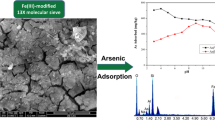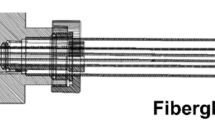Abstract
In this study, two types of adsorbents, Molecular sieve 3 Å and Silica gel 8–20 mesh were used for CO2 separation from CO2/N2 mixture in a fixed bed column. The impact of the temperature, superficial velocity and CO2 partial pressure on the breakthrough behavior, adsorption capacity and mass transfer zone has been thoroughly investigated. The breakpoint time declined with increased temperature, and maximal breakthrough period of 870 s was attained at a temperature of 30 °C using molecular sieve 3 Å, which is significantly higher than that obtained for Silica gel 8–20 mesh. Furthermore, the width of the mass transfer zone (MTZ) increases with reduced bed temperatures, which signifies the extent of utilization of bed capacity at the breakpoint. The breakpoint time increases with reduced superficial velocity, and the prolonged breakthrough time was achieved at a minimal superficial velocity of 0.026 m/s for MS 3 Å. The adsorption capacity reduced considerably with elevated temperature, and the maximal adsorption capacity of 903.8 mmol CO2/Kg adsorbent was determined at a temperature of 30 °C for MS 3 Å. The capacity increases considerably with increased feed superficial velocity, and the capacities of 792 mmol CO2/Kg and 152.9 mmol/Kg adsorbent were achieved for MS 3 Å and SG 8–20 mesh, respectively, at a constant superficial velocity of 0.042 m/s. The capacity increases considerably with increased partial pressure of the CO2, and an adsorption capacity of 894.7 mmol CO2/Kg adsorbent was acquired with an equilibrium partial pressure of 0.4 bars utilizing MS 3 Å. An adsorption capacity of 167.84 mmol/Kg adsorbent was evaluated at a partial pressure of 0.40 bars by controlling the temperature at 30 °C for SG 8–20 mesh. Owing to its remarkably higher capacity, the MS 3 Å adsorbent can be economically utilized for separation of CO2 from CO2/N2 mixture.
















Similar content being viewed by others
References
Hester RE, Harrision RM (2010) Carbon capture, sequestration and storage. The Royal Society of Chemistry, Cambridge
Li L, Zhao N, Wei W, Sun Y (2013) A review of research progress on CO2 capture, storage, and utilization in Chinese academy of sciences. Fuel 108:112–130
Rashidi NA, Yusuf S (2016) An overview of activated carbons utilization for the post combustion carbon dioxide capture. J CO2 Util 13:1–16
IEA (2003) CO2 capture at power stations and other point sources. Zero emission technologies for fossil fuels. OECD/IEA, Cedex, France
Lee SY, Park SJ (2015) A review on solid adsorbents for carbon dioxide capture. J Ind Eng Chem 23:1–11
Intergovernmental panel on climate change (IPCC) (2001) Climate change, Synthesis report. Cambridge University Press, Cambridge, UK
Alabadi A, Razzaque S, Yang Y, Chen S, Tan B (2015) Highly porous activated carbon materials from carbonized biomass with high capturing capacity. Chem Eng J 281:606–612
Figueroa JD, Fout T, Plasynski S, Mcllcried H, Srivastava RD (2008) Advances in CO2 capture technology-the US department of energy’s carbon sequestration program. Int J Greenh Gas Control 2:9–20
Gibbins J, Chalmers H (2008) Carbon capture and storage. Energ Policy 36:4317–4322
Blomen E, Hendriksa C, Neele F (2009) Capture technologies: improvement and promising developments. Energy Procedia 1:1505–1512
Choi WJ, Seo JB, Jang SY, Jung JG, Oh KJ (2009) Removal characteristic of CO2 using aqueous MEA/AMP solutions in absorption and regeneration process. J Environ Sci 21:907–913
Gomes J, Santos S, Bordado J (2015) Choosing amine based adsorbents for CO2 capture. Environ Technol 36:19–25
Gupta M, Coyle I, Thambimuthu K (2003) Strawman document for CO2 capture and storage technology roadmap. Canmet Energy Technology Centre Natural Resources, Canada
Brunetti A, Scura F, Barbieri G, Drioli E (2010) Membrane technologies for CO2 separation. J Membr Sci 359:115–125
Yang H, Xu Z, Fan M, Gupta R, Slimane RB, Bland AE, Wright I (2008) Progress in carbon dioxide separation and capture: a review. J Environ Sci 20:14–27
MacDowell N, Florin N, Buchard A, Hallett J, Galindo A, Jackson G, Adjman C, Williams CK, Shah N, Fennel P (2010) An overview of carbon dioxide capture technologies. Energy Environ Sci 3:1645–1669
Cohen SM, Chalmers HL, Webbe ME, King CW (2011) Comparing post-combustion carbon dioxide capture operation at retrofitted coal-fired power plants n the Texas and Great Britain electric grids. Environ Res Lett 6:1–14
Garcia S, Gil MV, Martin CF, Pis JJ, Rubiera F, Pevida C (2011) Breakthrough adsorption study of a commercial activated carbon for pre-combustion carbon dioxide capture. Chem Eng J 171:549–556
Valverde JM, Pontiga F, Soria-Hoyo C, Quintanlla MAS, Moreno H, Duran FJ, Espin MJ (2011) Improving the gas solids contact efficiency in a fluidized bed of carbon dioxide adsorbent fine particles. Phys Chem Chem Phys 13:14906–14909
Li J, Ma Y, McCarthy M, Sculley J, Yu J, Jeong H, Balbuen P, Zhou H (2011) Carbon dioxide-related gas adsorption and separation in metal-organic frameworks. Coord Chem Rev 255:1791–1823
Alonso M, Rodriguez N, Gonzalez B, Grasa G, Murillo R, Abanades JC (2010) Carbon dioxide capture from combustion flue gases with a calcium oxide chemical loop: experimental results and process developments. Int J Greenh Gas Control 4:167–173
Raganati F, Ammendola P, Chirone R (2015) CO2 capture by adsorption on fine activated carbons in a sound assisted fluidized bed. Chem Eng Trans 43:1033–1038
Abanadas JC, Anthony EJ, Lu DY, Salvador C, Alvarez D (2004) Capture of carbon dioxide from combustion gases in a fluidized bed of calcium oxide. AIChE J 50:1614–1622
Valverde M, Duran FJ, Pontiga F, Moreno H (2012) CO2 capture by enhancement in a fluidized bed of a modified Geldart C powder. Powder Technol 224:247–252
Shen C, Yu J, Li P, Grande CA, Rodrigues AE (2011) Capture of CO2 from flue gas by vacuum pressure swing adsorption using activated carbon beads. Adsorption 17:179–188
Sarkar AI, Aroonwilas A, Veawab A (2017) Equilibrium and kinetic behavior of CO2 adsorption onto zeolites, carbon molecular sieve and activated carbons. Energy Procedia 114:2450–2459
Al-Janabi N, Vakili R, Kalumpasut P, Gorgojo P, Siperstein FR, Fan X (2018) Velocity variation effect in fixed bed columns: a case study of CO2 captures using porous solid adsorbents. AIChE J 64:2189–2197
Shen C, Grande CA, Li P, Yu J, Rodrigues AE (2010) Adsorption equilibria and kinetics of CO2 and N2 on activated carbon beads. Chem Eng J 160:398–407
Xiang S, He Y, Zhang Z, Wu H, Zhou W, Krishna R, Chen B (2012) Microporous metal-organic framework with potential for carbon dioxide capture at ambient conditions. Nat Commun 3:1–9
Yoro KO, Singo M, Mulopo JL, Daramola MO (2017) Modeling and experimental study of the CO2 adsorption behavior of polyaspartamide as an adsorbent during post-combustion CO2 capture. Energy Procedia 114:1643–1664
Lu C, Bai B, Wu B, Su F, Hwang JF (2008) Comparative study of CO2 capture by carbon nanotubes, activated carbons, and zeolites. Energy Fuel 22:3050–3056
Al Mesfer MK, Danish M, Fahmy MY, Rashid MM (2018) Post combustion CO2 capture with activated carbons using fixed bed adsorption. Heat Mass Transf 54:2715–2724
Al Mesfer MK, Danish M (2018) Breakthrough adsorption study of activated carbons for CO2 separation from flue gas. J Environ Chem Eng 6:4514–4524
Dejang N, Somprasit O, Chindaruksa S (2015) A preparation of activated carbon from Macadamia shell by microwave irradiation activation. Energy Procedia 79:727–732
Jahangiri M, Shahtaheri SJ, Adl J, Rashidi A, Kakooei H, Forushani AR, Nasiri G, Ghorbanali A, Ganjali MR (2012) Preparation of activated carbon from walnut shell and its utilization for manufacturing organic-vapor respirator cartridge. Fresenius Environ Bull 21:1508–1514
Calvo-Munoz EM, Garcia-Mateos FJ, Rosas R-MJ, Cordero T (2016) Biomass waste carbon materials as adsorbents for CO2 capture under post-combustion conditions. Front Mater 3:1–14
Toprak A, Kopac T (2017) Carbon dioxide adsorption using high surface area activated carbons from local coals modified by KOH, NaOH and ZnCl2 agents. Int J Chem React Eng 15:1–16
Dantas TLP, Amorim SM, Luna FMT, Silva IJ Jr, Azevedo DCS, Rodrigues AE, Morera RFPM (2010) Adsorption of carbon dioxide onto activated carbon and nitrogen-enriched activated carbon-surface changes, equilibrium, and modeling of fixed bed adsorption. Sep Sci Technol 45:73–84
Regufe MJ, Ferreira AFP, Lourero JM, Shi Y, Rodrigues A, Ribeiro AM (2018) New hybrid composite honeycomb monolith with 13X zeolite and activated carbon for CO2 capture. Adsorption 24:249–265
Qasem NA, Ben-Mansour R, Habib HA (2017) Enhancement of adsorption carbon capacity of 13X with optimal incorporation of carbon nanotubes. Int J Energy Environ 8:219–230
Plaza MG, Duran I, Querejeta N, Rubiera F, Pevida C (2016) Experimental and simulation study of adsorption in post combustion conditions using a microporous biochar.1. CO2 and N2 adsorption. Ind Eng Chem Res 55:3097–3112
Zhang Z, Wang B, Sun Q (2014) Fly ash– derived solid amine sorbents for CO2 capture from flue gas. Energy Procedia 63:2367–2373
Hidayu AR, Muda N (2017) Impregnated palm kernel shell activated carbon for CO2 adsorption by pressure swing adsorption. Indian J Sci Technol 10:1–6
Patil P, Singh S, Kumar YM (2013) Preparation and study of properties of activated carbons produced from agricultural and industrial waste shells. Res J Chem Sci 3:12–15
Xia H, Cheng S, Zhang L, Peng J (2016) Utilization of walnut shell as a feedstock for preparing high surface area activated carbon by microwave induced activation: effect of activation agents. Green processing and synthesis 5:1–21
Mataji M, Khoshandam B (2014) Benzene adsorption on activated carbon from walnut shell. Chem Eng Commun 201:1294–1313
Al Mesfer MK (2020) Synthesis and characterization of high-performance activated carbon from walnut shell biomass for CO2 capture. Environ Sci Pollut Res 27(13):15020–15028
Tanada S, Kawasaki N, Nakamura T, Araki M, Tachibana Y (2000) Characteristics of nonafluorobutyl methyl ether adsorption onto activated carbon fibres and different size activated carbon particles. J Colloid Interface Sci 228:220–225
Balanay JG, Lungu CT (2012) Morphological and surface characterization of different types of activated carbon fibres. Adsorpt Sci Technol 30(4):355–367
Monazam ER, Spenik J, Shadle LJ (2013) Fluid bed adsorption of carbon dioxide on immobilized polyethylenimine (PEI): kinetic analysis and breakthrough behaviour. Chem Eng J 223:795–805
Harlick PJE, Tezel FH (2004) An experimental adsorbent screening study for CO2 removal from N2. Microporous Mesoporous Mate 76:71–79
Cavenati S, Grande CA, Rodrigues AE (2004) Adsorption equilibrium of methane, carbon dioxide, and nitrogen on zeolite 13X at high pressures. Chem Eng Data 49:1095–1101
Siriwardane RV, Shen MS, Fisher EP, Poston (2001) Adsorption of CO2 on molecular sieves and activated carbon. Energy Fuel 15:279–284
Kamiuto K, Abe S, Ermalina (2002) Effect of desorption temperature on CO2 adsorption equilibria of the honeycomb zeolite beds. Appl Energy 72:555–564
Ertan A (2004) CO2, N2 and Ar adsorption on zeolites. Dissertation, Izmar Institute of Technology, Turkey
Li Y, Yi H, Tang X, Li F, Yuan Q (2013) Adsorption separation of CO2/CH4 gas mixture on the commercial zeolites at atmospheric pressure. Chem Eng J 229:50–56
Acknowledgements
Authors are thankful to Deanship of Scientific Research (Grant No. R.G.P1.97/40) King Khalid University Abha KSA.
Author information
Authors and Affiliations
Corresponding author
Ethics declarations
Conflict of interest
On behalf of all authors, the corresponding author states that there is no conflict of interest.
Additional information
Publisher’s note
Springer Nature remains neutral with regard to jurisdictional claims in published maps and institutional affiliations.
Rights and permissions
About this article
Cite this article
Al Mesfer, M.K., Danish, M., Ali, I.H. et al. Adsorption behavior of molecular sieve 3 Å and silica gel for CO2 separation: equilibrium, breakthrough and mass transfer zone. Heat Mass Transfer 56, 3243–3259 (2020). https://doi.org/10.1007/s00231-020-02923-9
Received:
Accepted:
Published:
Issue Date:
DOI: https://doi.org/10.1007/s00231-020-02923-9




